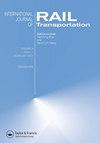循环轨道:无限长的轨道模型
IF 3.6
2区 工程技术
Q2 TRANSPORTATION SCIENCE & TECHNOLOGY
International Journal of Rail Transportation
Pub Date : 2022-07-31
DOI:10.1080/23248378.2022.2107581
引用次数: 2
摘要
本文章由计算机程序翻译,如有差异,请以英文原文为准。
Loop track: an infinite long track model
ABSTRACT This paper developed a track model called the ‘Loop Track’ that had a new function to simulate infinite long tracks without heavy data movement. The model was three-dimensional and considers rails, sleepers, ballast, subballast, and subgrade. Rails were modelled by using the Finite Element Method whilst all other components were modelled as equivalent rigid bodies connected by flexible force elements. The loop or infinite feature of the model was achieved by adding an extra boundary section to link the last node set to the first node set of the original track model. Case studies were conducted to simulate infinite long tracks and variable track conditions, as well as to determine the minimum track length required for different simulations. Results show that the recommended minimum track lengths for the simulated cases were 76 sleepers for vertical track dynamics and 301 sleepers for longitudinal track dynamics.
求助全文
通过发布文献求助,成功后即可免费获取论文全文。
去求助
来源期刊

International Journal of Rail Transportation
TRANSPORTATION SCIENCE & TECHNOLOGY-
CiteScore
6.90
自引率
15.00%
发文量
51
期刊介绍:
The unprecedented modernization and expansion of rail transportation system will require substantial new efforts in scientific research for field-deployable technologies. The International Journal of Rail Transportation (IJRT) aims to provide an open forum for scientists, researchers, and engineers in the world to promote the exchange of the latest scientific and technological innovations in rail transportation; and to advance the state-of-the-art engineering and practices for various types of rail based transportation systems. IJRT covers all main areas of rail vehicle, infrastructure, traction power, operation, communication, and environment. The journal publishes original, significant articles on topics in dynamics and mechanics of rail vehicle, track, and bridge system; planning and design, construction, operation, inspection, and maintenance of rail infrastructure; train operation, control, scheduling and management; rail electrification; signalling and communication; and environmental impacts such as vibration and noise. The editorial policy of the new journal will abide by the highest level of standards in research rigor, ethics, and academic freedom. All published articles in IJRT have undergone rigorous peer review, based on initial editor screening and anonymous refereeing by independent experts. There are no page charges and colour figures are included in the online edition free of charge.
 求助内容:
求助内容: 应助结果提醒方式:
应助结果提醒方式:


